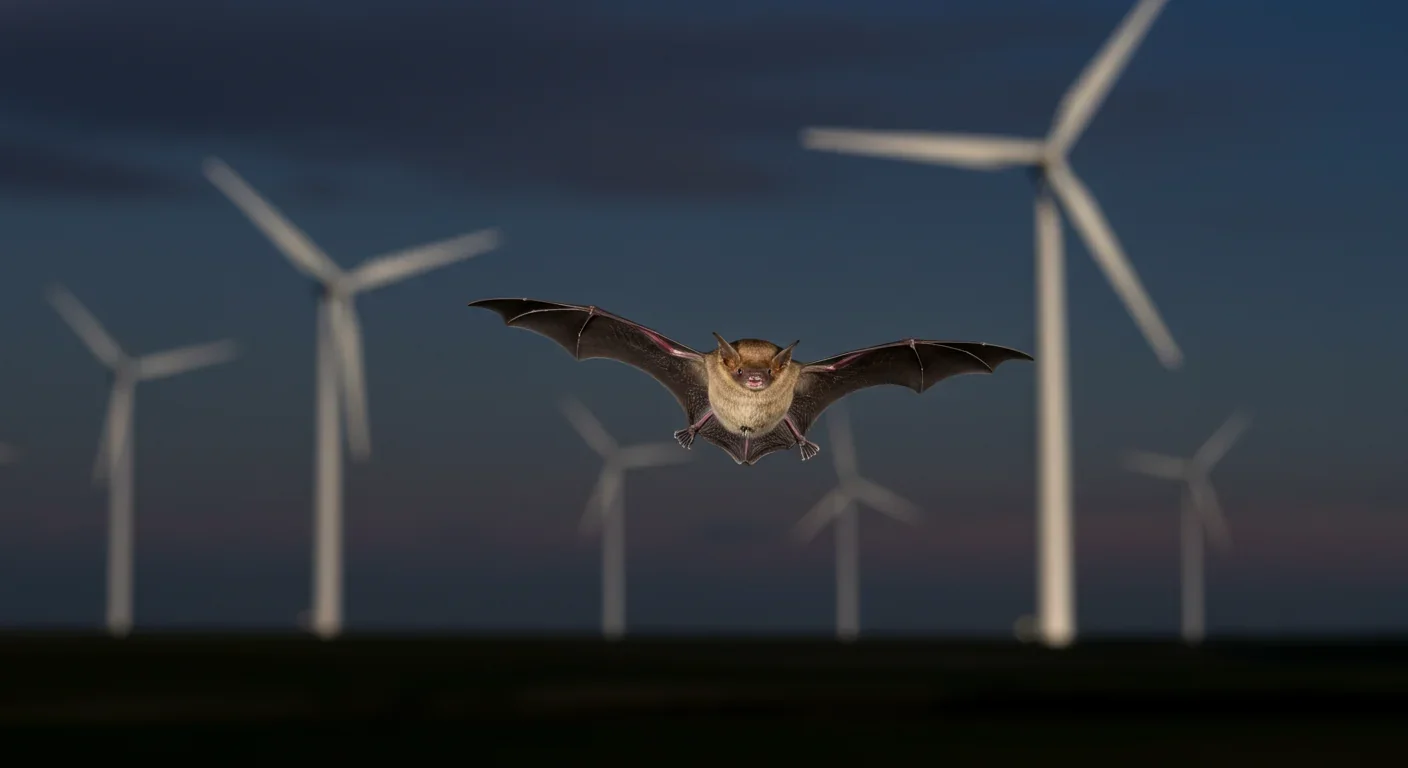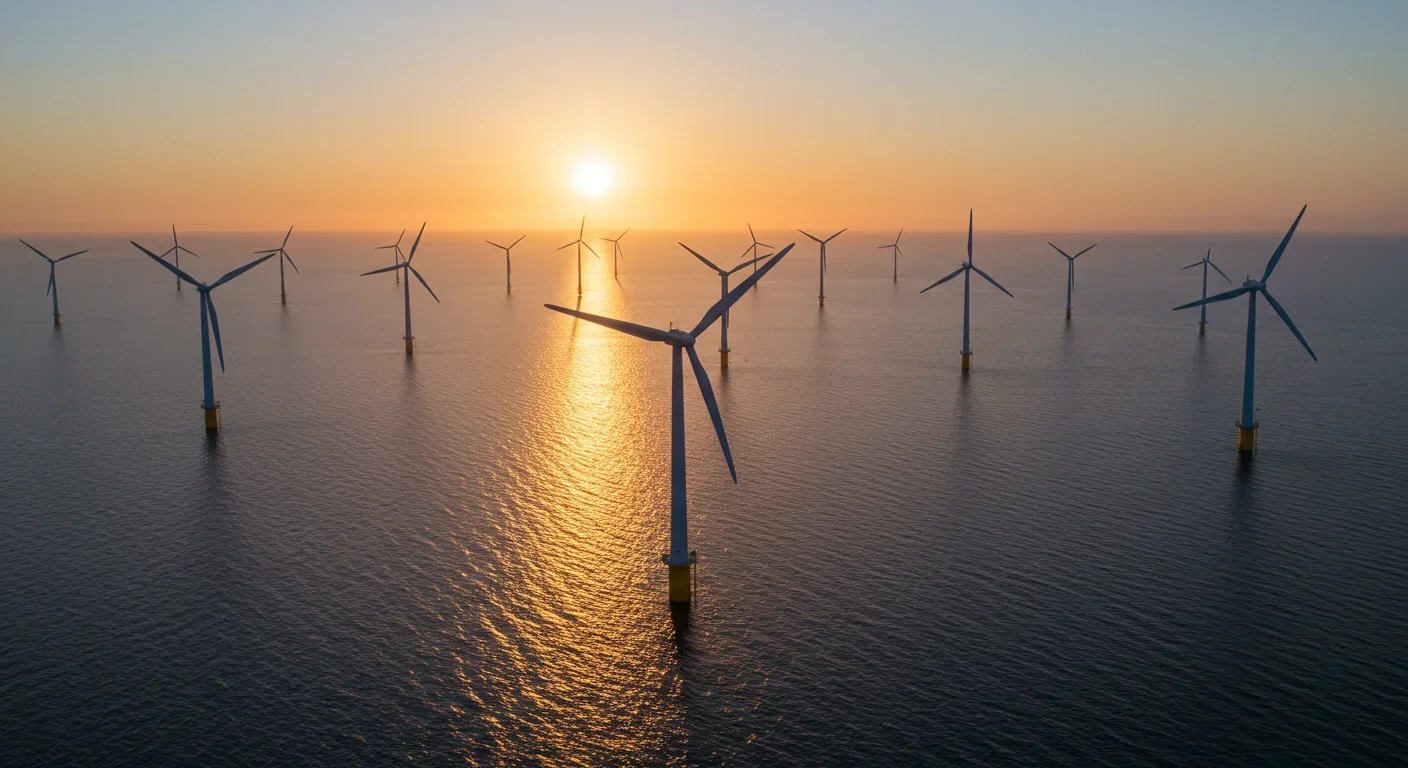Underground Air Storage: Renewable Energy's Hidden Battery

TL;DR: Wind farms are using bat-inspired algorithms to prevent wildlife collisions, reducing bat fatalities by 85% while cutting energy loss to just 3.2%. The technology mimics echolocation to optimize turbine control and farm layouts.

By 2030, scientists predict that wind turbines will generate over 20% of global electricity. But there's a problem we haven't solved yet: these spinning giants are accidentally killing millions of birds and bats every year while trying to save the planet. The irony is brutal. Renewable energy is supposed to protect ecosystems, not decimate them.
What if the solution was hiding in plain sight, encoded in the very creatures wind farms are harming?
Bats have been solving navigation problems for 50 million years. Every night, they launch into complete darkness and somehow avoid colliding with trees, buildings, and each other while hunting insects smaller than a fingernail. They do this by emitting ultrasonic pulses and listening for echoes, a biological radar so sophisticated that engineers have been trying to reverse‑engineer it for decades.
The bat algorithm mimics this natural process. Instead of sound waves, it uses mathematical iterations. Virtual "bats" explore a problem space, adjusting their search patterns based on feedback, just like real bats modify their flight paths based on echoes. The algorithm excels at finding optimal solutions in complex environments where traditional methods fail.
Researchers discovered they could model bat echolocation as a time‑varying autoregressive system, capturing both rapid frequency changes and gradual adjustments. This adaptive mechanism translates beautifully into computational optimization because it mirrors how nature solves multi‑variable problems in real time.
Here's what the wind industry doesn't advertise: turbines kill roughly 500,000 birds annually in the United States alone. Bat fatalities may be even higher, though they're harder to track because their small bodies decompose quickly or are scavenged before researchers can count them.
The collision risks fall into three categories. First, there's direct blade strike when animals fly through the rotor sweep zone. Second, barotrauma occurs when bats pass near blades and the sudden pressure drop ruptures their lungs. Third, attraction effects draw insects toward turbine lights and heat, which then lure insectivorous bats and birds into danger zones.
Current mitigation strategies are blunt instruments. Blanket curtailment shuts down turbines during peak migration seasons or low‑wind conditions when bats are active. This protects wildlife but slashes energy production by 30% or more during curtailment periods. It's the equivalent of turning off your car every time you see a crosswalk, whether anyone's crossing or not.
Radar detection systems can spot approaching flocks, but they're expensive and struggle to distinguish between species. Is that dot on the screen an endangered eagle or a harmless gull? By the time operators figure it out, it's often too late.
The standard bat algorithm works like this: each virtual bat represents a potential solution. Bats fly through the search space, adjusting their position (solution parameters) and velocity (rate of change) based on three factors: pulse rate, loudness, and frequency.
When a bat finds a promising solution, it emits louder pulses at higher rates, narrowing its search around that area. Poor solutions trigger quieter pulses and wider exploration. Over many iterations, the swarm converges on optimal values.
An improved bat algorithm (IBA) developed for wind‑solar‑storage planning added two enhancements. Chaotic mapping of pulse parameters helps avoid getting stuck in local optima, those deceptively good solutions that aren't actually the best. Levy flight, a random walk pattern observed in foraging animals, enables occasional long‑distance jumps to explore distant regions of the solution space.
In simulations on a 33‑bus electrical grid, the improved algorithm converged in just 17 iterations, compared to 39 for particle swarm optimization and 28 for the standard bat algorithm. It achieved photovoltaic utilization rates of 90.27% and wind energy utilization of 92.18%, both significant improvements over conventional methods.

Wind farm layout is a nightmare of competing constraints. Turbines need spacing to minimize wake effects where downstream turbines sit in the turbulent, slower‑moving air created by upstream ones. Wake interference can reduce power output by 10‑20% in poorly designed farms.
But spreading turbines farther apart increases cable costs, requires more land, and complicates grid connection. Offshore farms face additional challenges: foundation costs, wave loads, and accessibility for maintenance.
Traditional optimization approaches like linear programming struggle because the problem isn't linear. Wind doesn't blow uniformly, turbine efficiency varies with atmospheric conditions, and the optimal layout depends on wind rose patterns that shift seasonally.
The bat algorithm handles this complexity naturally. Researchers applied mathematical programming techniques to offshore wind farm layout, using the bat algorithm to simultaneously optimize turbine positions, foundation design, and cable routing. The algorithm evaluated thousands of configurations, balancing energy production against structural integrity and installation costs.
One study of real wind turbine expansion used a parallel collaborative multi‑objective optimization algorithm that incorporated bat algorithm principles. When expanding an existing wind farm, you can't just calculate the optimal layout from scratch because you're constrained by existing turbines. The algorithm had to find the best positions for new turbines while accounting for wake effects from existing ones.
The results were striking. The optimized expansion increased total farm output by 23% while using 15% fewer new turbines than the initial engineering proposal.
The real breakthrough came when researchers stopped trying to prevent collisions through better turbine placement and started using bat‑inspired intelligence to control when turbines operate.
The Turbine Integrated Mortality Reduction (TIMR) system combines acoustic bat detectors with a binary risk model integrated into the turbine control system. When wind speed drops below 8.0 meters per second and the acoustic detector registers at least one bat in the previous 10 minutes, the algorithm classifies conditions as high risk and triggers a 30‑minute curtailment.
After 30 minutes, the system re‑evaluates. If conditions remain risky, it curtails for another 30 minutes. If not, the turbine resumes normal operation. This creates a responsive feedback loop similar to how bats adjust their flight paths based on continuous echolocation data.
Field tests at the Blue Sky Green Field wind farm in Wisconsin produced remarkable results. TIMR decreased bat fatalities by 85% overall, with reductions ranging from 74.2% to 91.4% depending on species. Critically, this massive safety improvement came with only a 3.2% reduction in annual power generation and revenue.
Compare that to blanket curtailment, which achieves similar safety gains but reduces energy production 10 times more. Acoustically triggered curtailment proved that you don't need to sacrifice energy production to protect wildlife. You just need smarter algorithms.
Deploying bat‑inspired algorithms at scale requires solving several technical problems. First, acoustic detectors must reliably identify bat calls in noisy environments with wind, rain, and mechanical vibrations from the turbines themselves. Modern bat detectors use heterodyne, frequency division, or time expansion techniques, but each has tradeoffs in sensitivity and specificity.
Second, the detection system must integrate with supervisory control and data acquisition (SCADA) platforms that manage grid‑scale wind farms. TIMR accomplishes this by feeding risk scores directly into the SCADA system, which then issues curtailment commands just like it would for maintenance or grid stability reasons.
Third, operators need confidence that the algorithm won't trigger false alarms that unnecessarily curtail turbines. The 10‑minute detection window and 30‑minute curtailment cycle in TIMR represent carefully tuned parameters that balance responsiveness against stability.
Robin Radar systems note that detecting bats requires different solutions than detecting birds. Birds appear on radar; bats often don't because they're smaller and fly lower. This means effective collision prevention systems need multi‑sensor fusion: radar for birds, acoustic detectors for bats, and algorithms that integrate data from both.

The same optimization principles are finding applications across renewable energy systems. Bio‑optimization approaches for building energy management use bat algorithms to coordinate solar panels, wind turbines, and battery storage in microgrids.
The algorithm determines when to store energy versus when to feed it into the grid, when to charge batteries from solar versus wind, and how to balance load across different generation sources. In tropical climates with variable solar input and unpredictable wind patterns, this kind of real‑time optimization can increase renewable energy utilization by 15‑20%.
Researchers are exploring hybrid approaches that combine bat algorithms with machine learning. The bat algorithm handles global optimization, finding the general region of the best solution, while neural networks fine‑tune parameters based on historical performance data. This two‑stage process leverages the strengths of both methods.
As wind energy expands, wildlife protection regulations are tightening. The U.S. Fish and Wildlife Service has listed the tricolored bat as endangered, which means wind farm operators face significant liability for bat fatalities. Smart curtailment is becoming essential for regulatory compliance, not just environmental stewardship.
European regulations are even stricter. The Netherlands is testing innovative detection systems that can trigger automatic turbine shutdowns when protected bird species approach. These "shutdown on demand" systems represent the next evolution: not just species‑blind curtailment during risky conditions, but targeted protection for specific threatened species.
The Carbon Trust's bird collision avoidance study found that detection systems need to identify approaching birds at least 500 meters from turbines to allow sufficient time for shutdown. At typical turbine rotation speeds, you have maybe 30 seconds from detection to collision. The algorithm has to be fast.
Smart curtailment systems aren't cheap. Installing acoustic detectors, radar units, and integrated control systems can cost $50,000‑100,000 per turbine. For a 50‑turbine wind farm, that's a $2.5‑5 million investment.
But blanket curtailment costs more over time. A 10% reduction in annual energy production from a 100 MW wind farm translates to roughly $3‑4 million in lost revenue per year, depending on electricity prices. The smart curtailment system pays for itself in under two years.
There's also the avoided cost of regulatory penalties and project delays. Eagle fatalities at wind farms can trigger federal investigations and temporary shutdowns. DTBird technology, which uses camera‑based detection to protect eagles, has demonstrated collision risk reductions of 50‑82%. Operators view this as insurance against regulatory shutdown.
The economics improve further when you consider cumulative benefits. A turbine equipped with smart curtailment can operate in locations that would otherwise be off‑limits due to wildlife concerns. This expands the available land base for wind development, potentially more valuable than the operational savings.
The next generation of bat‑inspired algorithms will incorporate real‑time weather data, seasonal migration patterns, and machine learning models that predict bat activity based on temperature, humidity, and barometric pressure. Instead of reacting to bat detections, the system will anticipate high‑risk periods and adjust operations proactively.
Researchers are also developing coordinated control strategies for entire wind farms. Instead of each turbine making independent curtailment decisions, the bat algorithm could optimize across the entire farm: "If we have to curtail some turbines to protect bats, which ones should we shut down to minimize total power loss while providing adequate safe corridors?"
This farm‑level optimization gets complicated quickly because it has to account for wake effects. Curtailing an upwind turbine might actually increase power from downstream turbines by reducing turbulence. The bat algorithm is well‑suited to this kind of non‑linear, multi‑objective problem.
Integration with smart grid technologies represents another frontier. When wind farms can communicate with grid operators in real time, the bat algorithm could coordinate curtailment with demand response programs. Curtail during low‑demand periods when electricity is cheap, run at full capacity when demand and prices spike, and always protect wildlife. Everyone wins.
There's a meta‑lesson here beyond wind turbines and bats. Nature has spent billions of years solving optimization problems: how to forage efficiently, navigate complex environments, coordinate group behavior, and allocate limited resources. These biological solutions often outperform human‑designed algorithms because they've been tested and refined through evolutionary selection.
Ant colony optimization mimics how ants find the shortest path to food sources. Particle swarm optimization models the flocking behavior of birds. Genetic algorithms simulate evolutionary selection. The bat algorithm is part of this broader family of bio‑inspired computation.
What makes the bat algorithm particularly elegant is that it's being used to solve a problem created by humanity's energy needs while simultaneously protecting the biological inspiration for the algorithm itself. We're using bats to save bats, using their evolutionary wisdom to correct our engineering blind spots.
As we build more wind farms, install more solar panels, and construct more renewable energy infrastructure, we'll face similar challenges: how to generate clean energy without destroying the ecosystems we're trying to protect. The bat algorithm suggests an answer: study how nature solves problems, translate those solutions into mathematics, and apply them to human‑scale engineering challenges.
The turbines will keep spinning. But now, when bats approach on a warm September evening, the algorithm will hear them coming and give them safe passage through. It's not just smart engineering. It's technology learning to listen to the natural world instead of drowning it out.
And that might be the most important optimization of all.

MOND proposes gravity changes at low accelerations, explaining galaxy rotation without dark matter. While it predicts thousands of galaxies correctly, it struggles with clusters and cosmology, keeping the dark matter debate alive.

Ultrafine pollution particles smaller than 100 nanometers can bypass the blood-brain barrier through the olfactory nerve and bloodstream, depositing in brain tissue where they trigger neuroinflammation linked to dementia and neurological disorders, yet remain completely unregulated by current air quality standards.

CAES stores excess renewable energy by compressing air in underground caverns, then releases it through turbines during peak demand. New advanced adiabatic systems achieve 70%+ efficiency, making this decades-old technology suddenly competitive for long-duration grid storage.

Our brains are hardwired to see patterns in randomness, causing the gambler's fallacy—the mistaken belief that past random events influence future probabilities. This cognitive bias costs people millions in casinos, investments, and daily decisions.

Forests operate as synchronized living systems with molecular clocks that coordinate metabolism from individual cells to entire ecosystems, creating rhythmic patterns that affect global carbon cycles and climate feedback loops.

Generation Z is the first cohort to come of age amid a polycrisis - interconnected global failures spanning climate, economy, democracy, and health. This cascading reality is fundamentally reshaping how young people think, plan their lives, and organize for change.

Zero-trust security eliminates implicit network trust by requiring continuous verification of every access request. Organizations are rapidly adopting this architecture to address cloud computing, remote work, and sophisticated threats that rendered perimeter defenses obsolete.